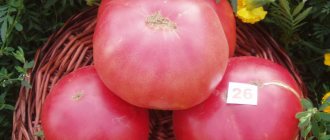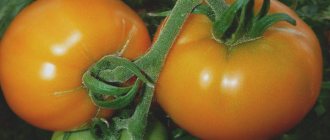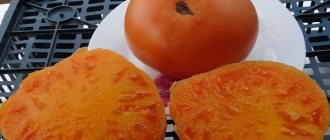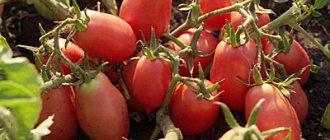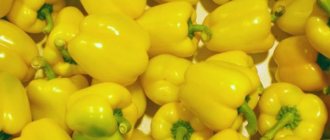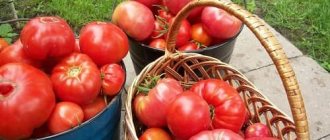Description of the variety
Applicant of the “Sugar Bison” variety, Moscow. Breeders Nastenko N.V., Kachainik V.G., Gulkin M.N., Kuzmina T.N. worked on the variety.
In 2013, Aelita submitted a tomato for testing to be included in the register of breeding achievements of the Russian Federation. The variety was studied and tested for two years. Patent number 7783. In 2015, it was entered into the register for cultivation in all regions of the Russian Federation and is recommended as:
- salad;
- indeterminate;
- mid-season;
- for open ground and greenhouses;
- heart-shaped fruit;
- pink color when fully ripe.
Feature of the bush
The height of the bush of the indeterminate variety “Sugar Bison” varies between 1.2-1.5 m. If you grow it in one shoot, then the optimal load allows you to get a good harvest.
The oblong green leaf is not able to cover the weighty fruits. They are well heated by the sun and accumulate sugar.
The first brush is laid after the 7th sheet. Subsequent ones after 2. Usually the cluster bears 3-4 fruits.
Features of the fruit
Even experienced vegetable growers will not be able to distinguish the fruits of “Sugar Bison” from similar varieties. His tomatoes:
- pink;
- heart-shaped;
- with slightly perceptible ribbing.
Distinctive features
Even with a great desire to describe the differences between “Sugar Bison” and other similar ones, it is not possible.
Some vegetable growers claim that only the “Sugar Bison” in its unripe state has a dark green spot at the stalk, and the fruit itself is light green. However, for a complete proof it is necessary to compare many varieties.
Reviews from gardeners who planted the variety
Sabrina, Kemerovo
I planted Sugar Bison last year. I was pleased with how the seeds sprouted and the harvest pleased me. The fruits are pink, large, sugary at the break and taste very good.
Volzhanka786, Kazan
Be sure to plant Sugar Bison - delicious tomatoes. Last year I raised it for the first time, and I will do it again this year. Those picked red don’t want to lie down at all, after 2-3 days black spots appear on them, if you just pickle them right away, but the skin of my tomatoes burst from the boiling marinade. The marinade is normal, you can eat it.
Barbie
Last year I planted Sugar Bison from Sibsad, everything was excellent - from germination to the fruits themselves, super, I’ll plant them again!
Ellenna
Last year I planted Sugar Bison - very tasty and large tomatoes. There were large ones up to 650 g. The yield was quite decent, 2-3 per cluster, the average fruit weight was 350 g, there were 5 clusters. In general, quite.
Tittan, Sevastopol
Sugar bison is a super-yielding variety of universal use. Height up to 2 m. Fruits are red, flat-round, 200-300 g. The taste is excellent. Stability is relative.
RYZANNA
My Sugar Bison grew up to the ceiling in a greenhouse last year, the harvest was average, but the fruits were tasty, but I wouldn’t call it sugar.
Galina, Stavropol region
The fruits were bright pink, round, smooth, weighing 250-300 g. Sugars of excellent quality. The productivity even in unfavorable years was pleasing. It was possible to collect up to 5-6 kg from one plant.
Diana
I planted the Sugar Bison tomato last year and got a very decent harvest. And the tomatoes were tasty and large. But I would really like to give up store-bought seeds and plant collection varieties.
Selena-tlt
The Sugar Bison bushes have grown powerful and tall. Tomatoes are of excellent presentation, with excellent taste. On average, the fruits weighed 200-300 g, the first ones weighed about 600 g. Used for processing, obtaining juices and pastes. And the fresh salads were delicious with these tomatoes! I recommend it to everyone!
Fruit characteristics
The density of the Sugar Bison fruits is average. When pressed, a slight springiness is felt.
The cross section makes it possible to calculate the seed chambers - there are more than six of them. They are not hollow and filled with pulp. Not a large number of seeds. A fully ripe tomato has a beautiful, pink color without a hint of greenery at the stalk.
The weight of the tomatoes is impressive. The lowest fruits on the shoot can reach a weight of 400 g. Those that are higher are less weighty. Average values are within 200-250 g.
When tasting the fruits when they were entered into the register, the variety was rated “good.” But it’s strange why such a tasty tomato didn’t get an “excellent” rating. There are two reasons for this:
- “Sugar bison” is sugar because the tomatoes taste sweet. However, for lovers of the classic tomato taste this is not always acceptable.
- The second reason is that the variety is very responsive to agricultural technology and is also capricious if something is not given to it.
Advantages and disadvantages
Describing the advantages of the “Sugar Bison” tomato, we can name the following parameters:
- large fruit;
- raspberry color;
- pleasant sweet taste.
A disadvantage of the variety can be considered its greater dependence on growing conditions. To show himself in all his glory he needs:
- fertile soils;
- timely feeding;
- regular watering;
- a lot of sun and warmth.
Productivity
The “Sugar Bison” variety has a marketable yield of 6.5-7.2 kg per m2 of film shelter planting area. These figures indicate that the yield in the garden may be even lower.
However, reviews of the variety indicate that where the best soils are given for tomato beds, the bushes show an excellent harvest of tasty and large tomatoes.
Growing region
Having passed tests in all regions of the country, the variety has proven itself well and was recommended for cultivation.
In the northern regions, for a good harvest, tomatoes are grown indoors. Southerners can afford both a greenhouse and a vegetable garden.
Climatic and natural resources greatly influence crop yields. An abundance of warmth and sun will add productivity and taste.
Care
The productivity of Sugar Bison tomatoes largely depends on proper and timely care.
A week after transplantation, tomatoes require protection from sunlight: at midday they are covered with agrofibre, burlap or tarpaulin. At night they are covered with film to protect them from freezing.
Growing a variety in a greenhouse includes regular ventilation, which will maintain humidity at a low level (50-55%) and temperature within 20-22 °C.
Watering
The first watering is carried out a week after planting. Water is applied to the root from a watering can or jar. Many gardeners prefer drip irrigation, the advantage of which is to provide the plants with the necessary amount of moisture. When using such a system, the risk of waterlogging is eliminated.
After watering, the soil in the garden bed is loosened and the rows are weeded. This helps keep the area clean and makes the soil light and loose. To prevent the stems from lying down, they are periodically hilled up, and as they grow, they are tied in stakes or trellises.
Bush formation
For the Sugar Bison variety, a bush with 2 stems is used. Leave the first flower cluster, then the stepson formed under it. When forming into one stem, all shoots growing from the axils of the leaves are removed. Additionally, they pluck out the leaves at the bottom of the stem, which take away moisture and nutrients from the crop.
Top dressing
Fertilizing has a positive effect on plant productivity
The description of this variety includes high yield (subject to a balanced diet).
Tomatoes require both organic and mineral components. Nitrogen helps them grow the root system and aerial parts, so 3 weeks after transplanting, the seedlings are watered with a solution of urea or nitrophoska - 15 g per 10 liters of water. 200 ml of the substance is poured under each bush.
At the initial stage of flowering, phosphorus and potassium are added: these components contribute to lush flowering and abundant fruiting. Use 0.5 liters of solution per plant (use 1 tablespoon of each component per bucket of water).
To avoid burning the roots, each root feeding is combined with watering. Additionally, foliar treatments are carried out with boric acid. Prepare a solution of 0.2 g of boron and 1 liter of hot water (50 °C). Tomatoes are irrigated with cooled fertilizer before flowering and during the fruiting phase.
Prevention
The description of the plant includes high sensitivity to brown spot, so the bed must be treated twice with copper-containing preparations (1% solution of copper sulfate or Bordeaux mixture). The procedure is carried out 20 days after transplanting the seedlings and 2 weeks before flowering.
Features of growing seedlings
"Sugar Bison" is a grateful variety. There is not a single moment that can be missed when growing seedlings. By carrying out the work systematically, you can grow excellent seedlings and get a good harvest.
Seed preparation
Advice. Do not sow with dry seeds. Firstly, the degree of freshness is unknown. Secondly, soaking and warming will speed up germination by 6-8 days, and for spring this is a lot.
To prepare seeds for sowing:
- place in a 0.5% manganese solution for 15 minutes, then rinse in water;
- wrap the seeds in a damp cloth or place in a container;
- place in a warm place, with a temperature not lower than 22 ᵒC for 2-3 days;
- check germination. Living seeds will show a root embryo.
After such preparation, seedlings will appear in 5-7 days.
If the seeds were purchased from the manufacturer, then there is no need for dressing, but they still need to be warmed up.
Container and soil
Specialty stores offer excellent containers for seedlings. They consist of:
- cells or cassettes;
- pallet;
- plastic transparent cover that acts as a greenhouse.
Such containers are light, practical, and durable. If you don't want to spend money, you can use what you have at hand. Experienced gardeners use:
- plastic boxes and parts thereof;
- containers;
- containers for water, juices, milk, bulk products;
- plastic disposable cups.
Any utensils that have drainage holes and a height of at least 5 cm can be used as containers for seedlings. Glass or plastic film is used as a greenhouse shelter.
Advice. If possible, buy universal soil for seedlings prepared by specialists.
You can also prepare your own earthen mixture. It should consist of:
- resting humus of farm animals or poultry;
- sand;
- matured compost;
- garden soil.
All components are mixed in equal proportions. To a bucket of this mixture you should add a glass of stove ash and 1 tablespoon of superphosphate. Ideally, such a mixture should be prepared in October. It should lie in a frost-free room during the winter and only by spring will it be ready for sowing. Just before sowing the seeds, it is spilled with a slightly pink solution of potassium permanganate.
Sowing
The tubs are filled with soil and compacted. The sprouted seeds are laid out on the surface. Apply 0.5 cm of soil and spray with warm water.
To create a greenhouse effect, crops are covered with glass or film.
Seed germination temperature is within 22-24 ᵒC. If the conditions are met, then shoots will appear in 5-6 days. When 70% of the seeds have germinated, the cover is removed. Otherwise, the seedlings will stretch out.
Growing and care
The microclimate for growing seedlings must meet the following parameters:
- the place is the brightest;
- daytime temperature 21-22 ᵒС;
- night temperatures within 16-17 ᵒC;
- daily ventilation for at least 10 minutes.
Advice. Make sure there is sufficient lighting for the seedlings, otherwise they will stretch out.
Watering should be carried out regularly, with the entire earthen clod wetted and the water escaping into the pan. The water temperature should be higher than the air temperature.
The seedlings grow quickly. The nutrients in the soil are enough for her to get stronger. If universal soil for seedlings was used for growing, then no fertilizing is carried out. If the soil is not prepared, then month-old seedlings can be watered with a 0.5% ammonium nitrate solution.
Bison Orange
| Variety name | Bison Orange |
| general description | Mid-season determinate variety |
| Originator | Russia |
| Ripening period | 120-125 days |
| Form | Round with pronounced ribbing |
| Color | Orange |
| Average weight of tomatoes | 850-900 grams |
| Application | Universal |
| Productivity of the variety | High |
| Features of cultivation | Bushes and brushes need staking |
| Disease resistance | Prevention can't hurt |
Orange bison is a determinate bush, up to 160 centimeters high. Recommended for growing in greenhouses. The bush requires the formation of a maximum of two trunks, with periodic removal of stepsons.
Medium late ripening. From planting seeds to receiving the first tomatoes 120-125 days. It is not only the bush that needs to be tied up, the brushes also need to be tied up because of the danger of breaking off under the weight of the fruit.
Description of the fruit:
- The fruits are large.
- They reach a weight of 850-900 grams.
- Well-defined orange color.
- Tomatoes are round in shape with pronounced ribbing.
- Suitable for canning in the form of sauces.
- Very tasty when making salads.
Features of cultivation
The seedlings will be ready for planting in the garden in 55-65 days from the moment of full germination. If the root system is closed, do a simple transshipment.
Transplanting seedlings into the ground
When choosing a landing site, you should consider that it should be:
- protected from the prevailing winds;
- without stagnant water;
- with fertile soils;
- without nightshade predecessors.
The distance between the bushes is 50-60 cm. Between the rows you need to maintain 60-70 cm. If the soils at the planting site are heavy and fresh, then they can be improved locally by adding a pre-prepared soil mixture. Seedlings need to be deepened up to the cotyledon leaves. If the plant is stretched out, it can be planted at a slight angle.
Features of cultivation and possible difficulties
There are no particular difficulties with growing the Sugar Bison variety. Timely implementation of agrotechnical measures allows you to obtain high-quality products with a good sales volume.
When growing a variety you need regular:
- watering;
- feeding;
- formation;
- fixation of shoots.
Sugar bison is a very responsive variety.
Errors during cultivation
If some rules of agricultural technology are violated, gardeners grow weak seedlings, the bushes develop slowly, bloom and bear fruit sparingly. There are several reasons for this:
- use of low-quality seeds (infected with diseases or expired);
- planting in too small a container using poor, heavy or acidified soil;
- violation of picking rules - planting tomatoes at a late stage of growth, transplanting without prior watering, which often leads to injury to the root system;
- lack of hardening, due to which the seedlings, after transplanting to the garden bed, turn yellow, wither and die from the sun or cold;
- violation of the watering regime, fertilizer application schedule and lack of regular weeding and loosening;
- non-compliance with crop rotation rules - annual planting of tomatoes in the same place is unacceptable, because there is a high risk of contracting the same infections (this crop can be returned to its original place only after 3 years);
- the lack of preventive treatments can also negatively affect the health of the bushes and their productivity.
Caring for tomatoes at a permanent growing site
An experienced gardener understands that absolutely everything is important when growing tomatoes.
Watering and fertilizing
Nutrients enter the plant by being absorbed by the root system. This is only possible in dissolved form. If you stop watering, the plant immediately stops development. Recovery takes time. Each delay delays fruiting and ripening.
The soil under tomatoes should always be moderately moist, and only the top layers can dry out slightly.
Watering should be deep, abundant, but not frequent. The watering process can and should be combined with fertilizing.
Organic substances are considered the best fertilizer for tomatoes. To prepare a nutritious mash, dissolve one kilo of animal manure or 0.5 kg of chicken droppings in a bucket of water. Then, when watering, 1 liter of mash is added to a bucket of irrigation water.
Loosening and weeding the soil
Removing weeds from a tomato plot is a very important point. Weeds compete with tomatoes for:
- light;
- water;
- space;
- nutrients.
You shouldn’t give weeds a single chance to take anything away from the tomato. Regular weed removal is the basis for epizootic well-being. Pathogens and pests find refuge on weeds.
Stepsoning
The cultivation of the “Sugar Bison” tomato variety should take place in two shoots. This is the optimal amount that a bison can “feed”. For proper formation, you should leave the lowest stepson; it will be the second shoot.
All stepsons that form on the trunk are removed when they reach 1-2 cm. At this moment they are soft and pliable. Just bite them with your fingernail.
Garter
As it grows and under the weight of the fruit, the tomato bends its shoot. It is bent and may break off. The harvest will be lost. To avoid troubles, shoots are regularly tied up. For this use:
- leg-split;
- twine;
- garden clips;
- special garters for plants.
Advice. When tying a shoot, do not make a tight knot.
Errors during cultivation
The “Sugar Bison” tomato variety is very responsive to care. Having planted seedlings and left them to survive, the vegetable grower hopes for a harvest. Unfortunately, it won't be there. A tomato will delight you with delicious fruits only if you regularly:
- feeding;
- watering;
- conducted in one or two shoots.
Advice. Don’t plan on putting extra load on the bush, “Sugar Bison” won’t be able to bear it, the fruits will be small.
The nuances of growing in open ground and in a greenhouse
If the soil is fertile and there is enough moisture, then there will be no nuances when growing in a garden or greenhouse.
The northern regions cannot afford open ground. And you shouldn’t rush to plant seedlings in an unheated greenhouse. Wait until the night temperature under the shelter does not drop below 16 degrees. During the day you need to ventilate.
Seedlings are planted in the garden only when spring frosts are no longer possible. If nature provides excess heavenly moisture, problems may also arise. With a sharp cold snap and the beginning of the rainy season, attention should be paid to preventive treatments. Brown tomatoes need to be removed and the bushes treated with fungicides.
How to grow tomatoes
The seedlings are transplanted into the beds 60-65 days after the first shoots appear. The optimum temperature is +16 °C during the day, +10 °C at night. Transplantation is carried out at the end of May or beginning of June.
Landing
Tomatoes are planted according to the 50*60 pattern (3-4 bushes per 1 m²) . 2 days before transplanting, the seedlings are watered, and the area where the tomatoes are planted is dug up. Cucumbers, zucchini, dill and carrots will be good predecessors for tomatoes, but in the area where tomatoes, potatoes and peppers grew, tomatoes are not planted - the plants are susceptible to the same diseases and suffer from the same harmful insects.
Before planting, the soil is disinfected with boiling water or a solution of potassium permanganate. After 4-5 days, the bushes are tied up for the first time.
More about large-fruited tomatoes:
Tomato “Big Momma” and the secrets of growing large fruits
Tomato Bull's heart, characteristics and description of the variety
Care
Plants are watered with warm, settled water strictly at the root, avoiding moisture getting on the stem and leaves .
Sugar bison is not a moisture-loving variety, so it is better to underwater tomatoes than to overwater them. To prevent the sun's rays from leaving burns on the leaf blades, water the tomatoes in the evening or early in the morning. After watering, the plants are immediately earthed up, weeds are removed from around them and the soil is loosened. As soon as the first ovaries form on the tomatoes, loosening and hilling is reduced to 1-2 times every two weeks.
Depending on the growth phase, tomatoes need different feedings . Nitrogen fertilizers are applied when the bush grows green mass and inflorescences form. Phosphorus-potassium - when the ovary forms on the bushes and the fruits grow. Fertilizing is applied every 12-14 days.
The variety is indeterminate, which means that the bush is not limited in growth . It is pinched when it reaches a height of 1.5-1.8 m, so that the upper fruits have time to ripen before the onset of frost. The plant is formed into one stem. The remaining stems and stepsons are removed.
Important! Stepchildren are removed by hand. When using a knife or blade, there is a risk of transferring an infection or fungus from bush to bush, which is still invisible to the human eye. If using a knife, the blade is disinfected after each plant.
Some gardeners form Sugar bison into two stems . The photo below shows the shaping of an indeterminate tomato.
To prevent tall bushes from bending to the ground and breaking under the weight of green mass and fruits, tomatoes are regularly tied up as they grow.
Features of cultivation and possible difficulties
When growing Sugar Bison tomatoes, a novice gardener may encounter a number of difficulties. The list presents the main ones and ways to solve them :
- When a large amount of greenery forms on the plant, the fruits become smaller and ripen slowly - as the tomato grows, the lower foliage is torn off.
- Tomatoes do not tolerate excess moisture well, but need regular watering - reduce the amount of watering without harming the plants by mulching the soil with peat, dry straw or grass.
- Tomatoes ripen at a lighter weight than the manufacturer claims - remove excess ovaries, leaving up to 3-4 inflorescences on one bunch.
Diseases and pests
Manufacturers do not indicate on the packaging information about the immune system of Sugar Bison tomatoes.
But experienced summer residents still carry out preventive measures against common tomato diseases and harmful insects. In greenhouses, tomatoes develop fungal diseases . To avoid this, gardeners carefully ventilate the shelters, and treat the plants with the following preparations:
- "Fitosporin";
- "Ekosilom";
- "Quadris";
- "Ridomil Gold".
Having discovered brown rot on tomatoes , remove the affected tomatoes and reduce nitrogen fertilizing and watering.
Plantings are attacked by harmful insects such as aphids and thrips. They are fought with the help of the drug “Zubr”. “Prestige” will save you from the Colorado potato beetle, and “Confidor” from the whitefly.
Advice. The smell of nasturtium or marigold repels many harmful insects, so these flowers are planted near tomatoes.
Diseases and pests
The Sugar Bison tomato variety is not particularly resistant to tomato diseases. If in open ground it is most often affected by late blight, then in greenhouses it can suffer from:
- cladosporiosis (yellow spots form on the leaves, the leaf falls off);
- ascochyta blight (cancer of the stem. Spots with gum oozing appear on the stem);
- anthracnose (spots appear on the fruits, then the tomatoes mummify);
- powdery mildew. (Several fungi work at once, causing chlorosis, then leaf necrosis)
If the greenhouse is affected by one of the fungi, you should change the crop for a while.
Among viral diseases, tomato aspermia, the so-called hairy leaves, can cause trouble.
Among the pests in greenhouse conditions, the whitefly is very dangerous.
Disease and pest control
As a rule, plant protection products are designed to comprehensively suppress pathogenic fungi. The methods of struggle are as follows:
- Cladosporiosis - use: “Pseudobacterin-2”, “Poliram”, “Fitosporin-M”, “Abiga-Pik”, “HOM”;
- Ascochytasis - drugs are used: “Trichodermin”, “Poliram”, “Rovral”;
- Anthracnose - sprayed: “Novosil”, “Quadris”, “Strobi”;
- Powdery mildew - fight with drugs: “Baktofit”, “Bayleton”, “Topaz”, “Quadris”.
A daily, careful inspection of the stems and leaves will help you not to miss the moment when the first stages of the spread of infection occur and take action.
Preventative treatment
If the weather gives you hot and dry days, you can postpone prophylaxis. As soon as the heat of the day changes to cold nights or frequent precipitation begins, prevention is needed.
If the tomato growing area is in mid-latitudes, you should not rely on the weather. As soon as a small ovary appears, spray with fungicides.
As a preventive measure you can use:
- Bordeaux mixture;
- Quadris;
- Ridomil Gold.
If the harvest period has arrived and the weather is not suitable, treatments are carried out weekly after collecting all the brown fruits.
Further care of seedlings
After the sprouts appear, the polyethylene is removed and the room temperature is reduced by 8-10 degrees to harden the seedlings. After about a week, you can again raise the temperature in the room to 20-22 degrees Celsius.
During the period of seedling growth, it requires regular watering, sufficient lighting for 12 hours and several feedings.
Seedlings should be watered as the top layer of soil dries out. Water for irrigation should be filtered and warm. Cold water can cause blackleg to develop on plants.
Advice!
To prevent seedlings from stretching out from lack of lighting, if necessary, install fluorescent lamps next to the containers. Plants require additional lighting; if there is not enough daylight, seedlings need 12 hours of lighting per day.
It is necessary to feed Sugar Bison tomato seedlings at least 2 times during its cultivation - 12-14 days after the picking procedure, and also a couple of weeks after the first feeding.
Picking seedlings should be done when a pair of true leaves appear on the plants. Seedlings should be transplanted into tall cups or containers, because before the plants are transplanted into greenhouses or open ground, they grow to 25-30 cm.
About a couple of weeks before transplanting plants to a permanent place, it is necessary to harden them. Containers with tomatoes are taken out into the fresh air for a short time at first, gradually increasing the time they remain outside.
Harvesting and application
Harvesting “Sugar Bison” is best done in a state of brown ripeness. In this case, the fruits ripen quickly in the house. Those that remain on the bushes will have a chance to grow.
Tomato "Sugar Bison" for salad purposes. This tomato is pleasant to contemplate on the bushes, hold in your hands, treat someone and, of course, eat.
The moderately dense skin does not allow the pulp to lose its neat ribs when slicing. In addition, the skin can be easily removed. To do this, just make a cross-shaped cut and pour boiling water over it. Then quickly immerse in cold water and remove the skin. The beautiful, saccharine naked “body” of the pink giant will appear before us. Using a sharp knife, you can make impeccable cutting into slices and slices. Prepared salads from this variety are especially tasty and elegant.
If you have surplus produce, you can prepare:
- tomato juice;
- sauce;
- tomato paste;
- lecho.
Processed products will be very tasty, but not beautiful. The pale color does not correspond to the understanding of the tomato product. Therefore, it is better to make an assortment and add red varieties to the pink tomato.
Main characteristics of the variety
Ripe large fruits of this variety can have different shapes - heart-shaped or flat-round with slight ribbing. The color of the skin of the fruit is green at the time of ripening, and fully ripe tomatoes have a rich crimson color. The weight of the first fruits of the Sugar bison, subject to the rules of agricultural technology, is high, about 300-350 g, but subsequent tomatoes will be smaller - no larger than 200 g.
The skin is thin (therefore it can burst during transportation), smooth with a slight gloss and characteristic ribbing in the upper part of the fruit. The pulp is compacted, fleshy, with 4-5 seed chambers, which contain some liquid and seeds. The taste of ripe Sugar Bison fruits is sweetish with a characteristic sourness.
Photo of Sugar Bison tomato pulp
The harvested crop is versatile - the fruits can be eaten fresh, added to vegetable salads or snacks. Also, tomatoes of this variety make delicious preparations for the winter - pickles, thick paste, delicious juice, canned salads.
On a note!
When transporting harvested fruits, care should be taken as the thin skin of the tomatoes may crack. The harvested crop has a fairly long shelf life.
Another positive quality of the collected Sugar Bison fruits is their ability to ripen
– if they are harvested green at the end of the season, then when stored at home, the tomatoes gradually ripen over 30-45 days. At the same time, the fruits do not wither and do not lose their taste.
Reviews
Those vegetable growers who have already enjoyed the Sugar Bison variety of tomatoes have mostly positive reviews.
Oksana
Samara city
Manufacturer – Vegetable Lux
Where they grew it - vegetable garden
I'm happy with the tomato, very large and sweet. One bush bears an average of 10-12 fruits of 250-300 g each. The largest weighed 482 g. An amazing tomato, I will definitely sow it again.
Stepan Stanislavovich
City Ufa
Manufacturer – Vegetable Lux
Where they were grown - greenhouse and vegetable garden
In my region, this variety needs to be grown in a greenhouse. There will be both taste and weight. It didn't work out in the garden. I got caught in the rain, late blight started, it’s really my own fault, but I didn’t get a harvest. I will plant again, but only in a greenhouse. You need to sow no later than March 10. The taste is very good, pleasant.
Gregory
Voronezh city
Manufacturer: Aelita
Where they grew it - vegetable garden
Seed germination is excellent. I grew beautiful seedlings. I planted it early, but covered it with eggplants. Everything turned out great. I set up high poles, and he drove me to 3 meters. I treated it for late blight 3 times, there were no lesions. The cold came early, I removed everything and brought it into the house. The first ones were tasty, the ones that didn’t grow up weren’t very good. I'm pleased with the harvest and will definitely plant more.
Katerina
City - Stavropol Territory
Manufacturer - SeDek
Where they grew it - vegetable garden
Strange affair. The photo showed a hearty tomato, mine was almost flat. But I’m happy with the harvest, tasty, pink, fleshy. The shoots were very tall, it was difficult to tie them up, but we were pleased with the yield. The green ones that I removed lasted a long time and did not spoil.
Tomato Sugar Bison: reviews from those who planted
Natalya, 45 years old, Chelyabinsk region:
I have several greenhouses on my site in which I grow several varieties of Bison tomatoes - Yellow, Black. Two seasons ago I also planted Sugar Bison. The bushes of this variety are distinguished by good resistance to diseases; with regular fertilizing, the yield only increases. The fruits have good taste and versatility of use. I will continue to grow this variety.
Ekaterina, 55 years old, Samara region:
I’ve been planting the Sugar Bison tomato for several years now, and I’m quite happy with my choice. The seedlings grow large, quickly acclimatize in greenhouse conditions, love feeding and do not require frequent watering. The fruits have a sugary taste and are good in salads and other snacks. For the winter, I make very tasty adjika with garlic or horseradish from the harvested crop.
Despite the fact that this tomato variety was included in the Russian State Register recently, many vegetable growers actively plant the Sugar Bison tomato in their greenhouses and film greenhouses every year and are quite satisfied with the results - the variety’s yield, the taste of the fruit, and its fairly unpretentious care.
Recently also searched:
Photo
Sugar bison tomato is beautiful. Looking through the photo, the vegetable grower understands that such a variety must be grown.
The photo on the package with seeds does not always correspond to what grew on the bushes. This is a feature of the variety. "Bison" is very responsive to fertility and care, which is why there can be a significant difference.
Video
We invite you to watch a short video about Sugar Bison tomatoes and other sweet varieties of tomatoes:
| Super early | Mid-early | Late ripening |
| Alpha | King of the Giants | Premier |
| Pickling miracle | Supermodel | Grapefruit |
| Labrador | Budenovka | Yusupovsky |
| Bullfinch | Bear Paw | Rocket |
| Solerosso | Danko | Digitomandra |
| Debut | King Penguin | Rocket |
| Alenka | emerald apple | Snowfall F1 |
Description of Bison variety tomatoes and its varieties with photos
The Bison tomato belongs to the mid-early and tall varieties. The bushes of this tomato grow high - up to 180 cm, with powerful and gnarled stems of light green color. Since the bushes grow quite tall, they require staking, otherwise they may break under the weight of the fruit. Tying the stems also simplifies the harvesting process and protects the fruits from rodents, insects and excessive moisture.
Breeders have developed several varieties of Bison tomato, namely black, yellow, pink and orange. Let's look at each variety separately.
Bison black
This variety of tomatoes has a flat-round shape, with slight ribbing on the sides. Fruit weight is 250-300 grams. The fruits are dark purple in color, with a slight purple tint. The taste of tomato is pronounced and has a long fruity aftertaste. Good for fresh consumption. The fruits are not suitable for pickling, as they crack greatly.
Bison yellow
Tomatoes of this variety have very dense and fleshy pulp, which has a great taste. The shape of the fruit is flat-round with clearly visible ribbing on the sides. The weight of the fruit ranges from 300 to 500 grams. The color of the fruit is golden yellow. This variety is distinguished by a small number of seeds inside the fruit. Yellow bison is good for making salads and all kinds of sauces.
Bison pink (Sugar Bison)
The color of the fruit of this tomato is pink with a slight reddish tint. Tomatoes are quite dense, have fleshy, juicy pulp. Inside the fruit has a small number of chambers. The shape of the pink bison is round, with slightly ribbed sides, and can be heart-shaped. The very first tomato fruits grow up to 500 grams, and the weight of subsequent fruits varies from 200 to 300 grams.
Bison orange
Tomatoes of this variety have a bright orange color and grow 800-850 grams each. The fruits have a round shape and slight ribbing on the sides. Tomatoes have a sweet taste and are great for making a variety of sauces.
These varieties of tomato differ only in color, but all characteristics are almost identical.
The fruits of the Bison tomato are quite large and fleshy, slightly flattened, the sides of the tomatoes are ribbed. The weight of the Bison tomato fruit varies from 250 to 350 grams, but there are also giants that weigh up to 900 grams. The skin of the fruit is tender and thin. Tomatoes have juicy, soft flesh with a sweetish taste.
The growing season of the Bison tomato, from sowing the seeds to harvesting the first harvest, is 115-125 days.
Pros and cons of the variety
Bison tomatoes have many positive qualities, thanks to which not only gardeners, but also many agricultural firms began to grow them.
The main advantages of tomato:
- Original appearance that arouses interest. Tomatoes look great not only on the branches, but also on the table. Appetizing tomatoes can decorate any area and any table.
- An interesting taste that cannot be compared with other types of tomatoes. It is appreciated by supporters of everything unusual and unique.
- Quite high yield. If the plant is grown correctly, then at least five kilograms of fruit can be collected from one bush.
- This tomato can be grown throughout the year. All the money that will have to be spent on heating the greenhouse will soon pay off due to the fact that it will be possible to eat fresh vegetables all year round. You can also get good money by selling tomatoes in the winter and spring.
- Tomato Bison has good immunity to fungal diseases. The plant does not get sick during the entire period of growth and fruiting.
But besides the positive qualities, there are also disadvantages:
- Quite a long ripening period. Bison tomatoes ripen 2-3 weeks longer than other tomato varieties.
- They require careful and regular care. If you violate the watering norms and the amount of fertilizing, this will lead to poor yields and possible death of the bush.
- Poor transportability and short storage. The delicate skin of the fruit deteriorates from pressure and shaking.
Productivity
Bison tomatoes are mid-season varieties and the first ripe fruits can be harvested within 115-120 days after planting the seeds in the ground. From one tomato bush you can collect 4-6 kg of ripe fruits per season. From one square meter the yield reaches up to 25 kg.
Since the Bison tomato grows mainly in heated greenhouses, it can be grown in any region of the country. In regions where there is a stable, warm, mild climate, this type of tomato can be grown in open ground. If the greenhouse is heated, tomatoes can be grown throughout the year.
Features of growing the Sugar Bison variety and caring for it
The seeds of the variety should be sown at the end of March or at the beginning of April . If the plant will be grown in large quantities, then sowing should be done in large boxes, and peat tablets can be used to grow a couple of bushes.
To create an earthen composition, you need to mix peat, garden soil, humus and wood ash (2:1:1:1). In addition, you can add some potassium fertilizers and superphosphate. This mixture needs to be sifted and steamed in a double boiler. Thanks to this, you can get rid of bacteria and fungal spores. And the soil will become loose, moisture-absorbing and breathable.
Seedlings should be placed on a south-facing window during the day, and simply left on the windowsill at night. In this case, the temperature should be 22 degrees during the day and 18 degrees at night.
After sowing, the seedlings are watered a couple of times. She does not need auxiliary feeding. In peat tablets, out of eight sifted, only three can sprout.
A week in advance, beds should be prepared for planting seedlings. Their height is 30 cm and width up to 90 cm. In addition, drainage should be prepared and the soil should be loosened. Before planting, the furrows must be watered with an unsaturated solution of potassium permanganate. You can also apply complex mineral and organic fertilizers.
The bushes do not need to be watered for the first 14 days. And then they are regularly irrigated with warm water. With the help of weeding, the roots will breathe better and let water through.
The first loosening is carried out immediately after planting the seedlings in the greenhouse, and after that this procedure is carried out every two weeks. Loosening is carried out at a depth of 5 cm. Weeds also need to be removed from time to time, as they negatively affect the growth and yield of tomatoes.
